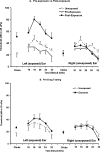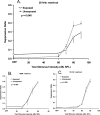Vigabatrin, a GABA transaminase inhibitor, reversibly eliminates tinnitus in an animal model
- PMID: 17221143
- PMCID: PMC2538419
- DOI: 10.1007/s10162-006-0067-2
Vigabatrin, a GABA transaminase inhibitor, reversibly eliminates tinnitus in an animal model
Abstract
Animal models have facilitated basic neuroscience research investigating the pathophysiology of tinnitus. It has been hypothesized that partial deafferentation produces a loss of tonic inhibition in the auditory system that may lead to inappropriate neuroplastic changes eventually expressed as tinnitus. The pathological down-regulation of gamma-amino butyric acid (GABA) provides a potential mechanism for this loss of inhibition. Using an animal model previously demonstrated to be sensitive to treatments that either induce or attenuate tinnitus, the present study examined the effect of the specific GABA agonist vigabatrin on chronic tinnitus. It was hypothesized that vigabatrin would decrease the evidence of tinnitus by restoring central inhibitory function through increased GABA availability. Vigabatrin has been demonstrated to elevate central GABA levels (Mattson et al. 1995). Tinnitus was induced in rats using a single 1-h unilateral exposure to band-limited noise, which preserved normal hearing in one ear. Psychophysical evidence of tinnitus was obtained using a free-operant conditioned-suppression method: Rats lever-pressed for food pellets and were trained to discriminate between the presence and absence of sound by punishing lever pressing with a mild foot shock (0.5 mA; 1 s) at the conclusion of randomly introduced silent periods (60 s) inserted into background low-level noise. Additional random insertion of pure tone and noise periods of variable intensity enabled the derivation of psychophysical functions that reflected the presence of tinnitus with features similar to 20-kHz tones. Vigabatrin was chronically administered via drinking water at 30 and 81 mg kg-1 day-1, with each dose level tested over 2 weeks, followed by a 0-mg washout test. Vigabatrin completely and reversibly eliminated the psychophysical evidence of tinnitus at both doses. Although vigabatrin has serious negative side effects that have prevented its clinical use in the USA, it is nevertheless a potentially useful tool in unraveling tinnitus pathophysiology.
Figures







References
-
- {'text': '', 'ref_index': 1, 'ids': [{'type': 'DOI', 'value': '10.1016/S0378-5955(97)00081-6', 'is_inner': False, 'url': 'https://doi.org/10.1016/s0378-5955(97)00081-6'}, {'type': 'PubMed', 'value': '9282898', 'is_inner': True, 'url': 'https://pubmed.ncbi.nlm.nih.gov/9282898/'}]}
- Backoff PM, Palombi PS, Caspary DM. Glycinergic and GABAergic inputs affect short-term suppression in the cochlear nucleus. Hear. Res. 110:155–163, 1997. - PubMed
-
- {'text': '', 'ref_index': 1, 'ids': [{'type': 'DOI', 'value': '10.1016/S0378-5955(99)00071-4', 'is_inner': False, 'url': 'https://doi.org/10.1016/s0378-5955(99)00071-4'}, {'type': 'PubMed', 'value': '10452378', 'is_inner': True, 'url': 'https://pubmed.ncbi.nlm.nih.gov/10452378/'}]}
- Backoff PM, Shadduck Palombi P, Caspary DM. Gamma-aminobutyric acidergic and glycinergic inputs shape coding of amplitude modulation in the chinchilla cochlear nucleus. Hear. Res. 134:77–88, 1999. - PubMed
-
- {'text': '', 'ref_index': 1, 'ids': [{'type': 'DOI', 'value': '10.1016/S0030-6665(02)00171-8', 'is_inner': False, 'url': 'https://doi.org/10.1016/s0030-6665(02)00171-8'}, {'type': 'PubMed', 'value': '12856296', 'is_inner': True, 'url': 'https://pubmed.ncbi.nlm.nih.gov/12856296/'}]}
- Bauer CA. Animal models of tinnitus. Otolaryngol. Clin. North Am. 36:267–285, 2003. - PubMed
-
- {'text': '', 'ref_index': 1, 'ids': [{'type': 'PMC', 'value': 'PMC3201094', 'is_inner': False, 'url': 'https://pmc.ncbi.nlm.nih.gov/articles/PMC3201094/'}, {'type': 'PubMed', 'value': '11545150', 'is_inner': True, 'url': 'https://pubmed.ncbi.nlm.nih.gov/11545150/'}]}
- Bauer CA, Brozoski TJ. Assessing tinnitus and prospective tinnitus therapeutics using a psychophysical animal model. J. Assoc. Res. Otolaryngol. 2:54–64, 2001. - PMC - PubMed
-
- {'text': '', 'ref_index': 1, 'ids': [{'type': 'DOI', 'value': '10.1097/01.MLG.0000216812.65206.CD', 'is_inner': False, 'url': 'https://doi.org/10.1097/01.mlg.0000216812.65206.cd'}, {'type': 'PubMed', 'value': '16652071', 'is_inner': True, 'url': 'https://pubmed.ncbi.nlm.nih.gov/16652071/'}]}
- Bauer CA, Brozoski TJ. Effect of gabapentin on the sensation and impact of tinnitus. Laryngoscope 116:675–681, 2006. - PubMed
Publication types
MeSH terms
Substances
Grants and funding
LinkOut - more resources
Full Text Sources
Other Literature Sources
Medical

